The rich tapestry of ancient Egyptian culture, though distant in time, still threads its way into our modern world. Ra, a central figure in Egyptian mythology, stands testament to this enduring legacy. Rather than merely resting within the confines of old scrolls or on the fading frescoes of temple walls, his influence permeates contemporary thought and art. This dynamic deity, once revered as the sun itself, remains a beacon of the timeless allure and profundity of Egyptian lore.
| Origin | Ancient Egyptian Civilization |
|---|---|
| Classification | God |
| Family Members | According to some myths, Ra is self-created; Hathor (Daughter), Sekhmet (Daughter), Bastet (Daughter), Shu (Son), Tefnut (Daughter) are often considered his children in various myths |
| Region | Egypt |
| Associated with | Sun, Creation, Power, Kingship, The Sky |
1. Historical Background of Ra:
Long before the pyramids graced the horizon of Giza or the Sphinx stood as a sentinel to time, the lore of Ra had begun its indelible imprint on the annals of Egyptian history. The earliest mentions of Ra can be traced back to the Old Kingdom period, inscribed with reverence in pyramid texts and tombs of ancient pharaohs. These inscriptions not only venerated him as a deity but also celebrated the daily rebirth of the sun, embodying Ra’s eternal journey.
The reverence for Ra was not merely symbolic; it intertwined with the very fabric of Egyptian religious practices. Temples dedicated to him, notably in Heliopolis, were not just places of worship but also centers of knowledge, astronomy, and philosophy. Priests dedicated to Ra engaged in complex rituals, heralding the sunrise and bidding farewell at dusk, embodying the cyclical nature of life and death that Ra represented. As dynasties came and went, Ra’s importance in the Egyptian pantheon fluctuated, sometimes merging with other deities like Horus to form ‘Ra-Horakhty’ or with Atum to signify a more encompassing creator deity. Yet, through these transitions, one thing remained constant: Ra’s quintessential role as the life-giver, the illuminator of worlds, both seen and unseen.
By understanding Ra’s historical evolution, we glimpse the dynamic nature of Egyptian religious practices, offering insights into how beliefs morphed, merged, and remained resilient across millennia.
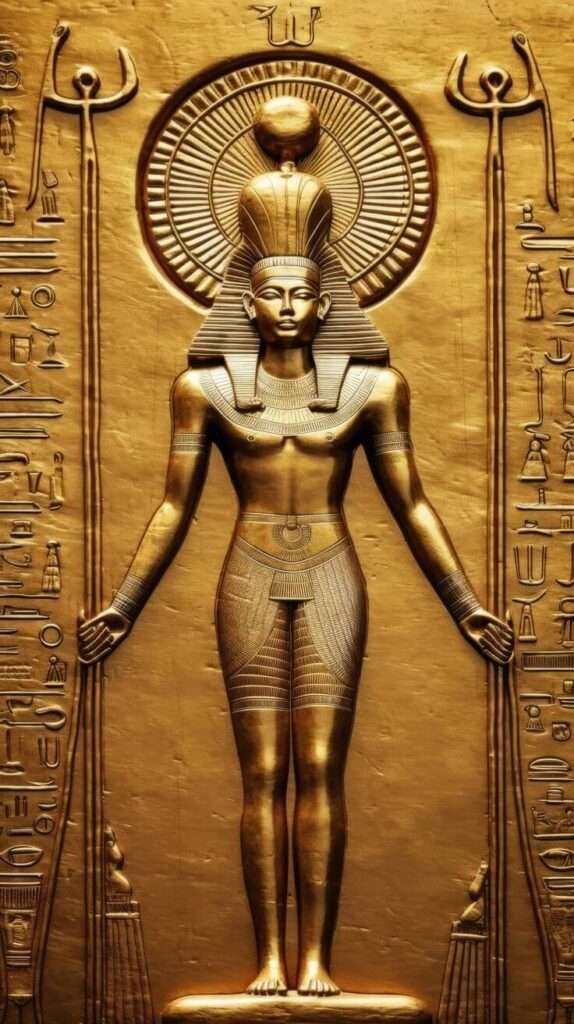
2. Ra’s Role and Significance:
The Egyptian skies, with their brilliant azure backdrop, held a divine narrative each day. At its heart was Ra, the Sun God. His daily journey from east to west symbolized life’s cyclical nature. Ra’s role extended beyond the heavens; he battled chaos, ensuring the world’s order.
Ra’s significance intertwined with other deities. Ra-Horakhty represented his connection with Horus, emphasizing dominion over day and night. With Atum, Ra embodied both the sun and creation’s force.
Ra permeated daily life. Temples, obelisks, and amulets celebrated him. Inscriptions and artworks adorned homes and tombs, honoring Ra’s pervasive influence. Rituals, festivals, and hymns echoed Egypt’s landscape, highlighting Ra’s central role.
Exploring Ra’s multifaceted role unveils not just a deity’s importance but an entire civilization’s ethos, revealing their understanding of life, cosmos, and the divine.
3. Iconography and Symbols Associated with Ra:
The vast expanse of Egyptian art and inscriptions is a testament to the civilization’s innate ability to convey profound spiritual truths through symbols. Ra, being paramount in the Egyptian pantheon, is represented by a rich tapestry of images, each embodying a distinct aspect of his divinity.
a. The Sun Disk and the Falcon:
At the heart of Ra’s iconography is the sun disk, a golden circle radiant with rays, symbolizing the omnipotent force that gives life to the world. Often, this sun disk is depicted as cradled between the horns of a sacred cow, representing the goddess Hathor, a connection emphasizing nourishment and protection. Furthermore, the falcon, a bird renowned for its keen sight and dominion over the skies, becomes the chosen vessel for Ra’s representation. When combined, the falcon crowned with the sun disk becomes a powerful emblem, embodying Ra’s watchful gaze over creation and his unchallenged sovereignty in the heavens.
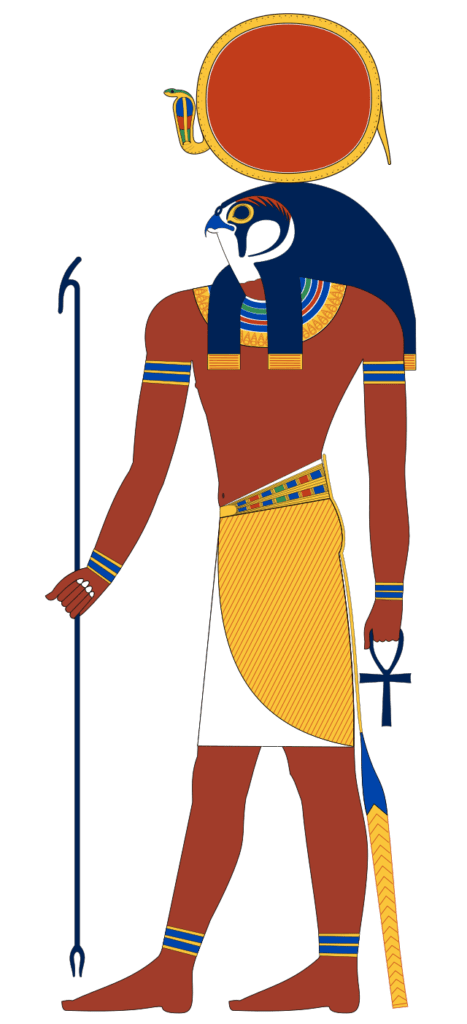
b. The Solar Barque:
As night descends and the sun disappears beyond the horizon, ancient Egyptians believed that Ra embarked on a perilous journey through the underworld in a sacred vessel known as the “solar barque.” This intricate ship, often depicted in detailed reliefs, symbolized Ra’s passage through the twelve hours of the night, confronting and subduing the forces of chaos, especially the serpent Apep. The imagery of the solar barque not only narrates Ra’s indomitable spirit but also underscores the cyclical nature of life, death, and rebirth.
c. Other Common Symbols:
Beyond these central images, several other symbols are associated with Ra. The ‘ankh,’ a cross with a looped top, often seen in Ra’s grasp, signifies life and immortality. Another frequent emblem is the ‘was’ scepter, symbolizing power and dominion. Both these items, when depicted alongside Ra, reiterate his role as the giver of life and the ultimate sovereign.
Exploring the iconography associated with Ra offers more than just an aesthetic appreciation of Egyptian art. It provides a visual gateway into understanding the deep spiritual and philosophical tenets of a civilization that saw divinity in the cosmos’s rhythms and intricacies.
4. Myths and Stories Centered Around Ra:
Ancient Egyptian civilization, with its intricate web of myths and legends, offers a treasure trove of tales that breathe life into its gods and goddesses. Ra, being paramount, features prominently in many such narratives, each revealing a facet of his might, wisdom, or vulnerability.
a. The Creation Myth:
In the silent void of nothingness, where the dark, chaotic waters of Nun reigned supreme, a mound emerged, breaking the stillness. From this primeval hill, Ra, often symbolized as a radiant child or a blossoming lotus, announced his presence, dispelling darkness with his brilliance. As he spoke names, beings came into existence – gods, humans, animals, and the very elements. His tears gave birth to humanity, forging a bond between the creator and the created. This tale is not just about creation but a reflection of the Egyptian belief in the power of names and the spoken word.
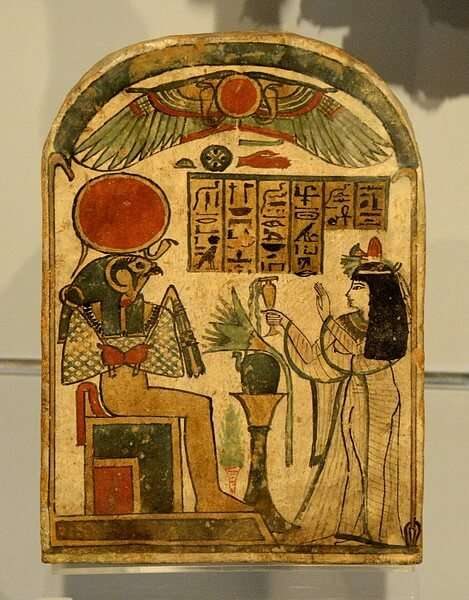
b. The Story of Isis, Ra, and the Secret Name:
Even gods, in their might, have moments of vulnerability. Such is the tale of Isis, the enchantress, and Ra. With an ambition to become the most powerful deity, Isis conjures a serpent using Ra’s saliva and earth. The serpent bites Ra, causing unbearable pain. The cure? Ra’s secret name, which holds his very essence and power. After much persuasion, Ra divulges his true name, healing himself and inadvertently granting Isis unparalleled power. This story underscores the themes of cunning, the potency of names, and the intricate balances of power in the divine realm.
c. Ra’s Battle with the Serpent Apep:
Every dawn and dusk, as Ra journeyed across the sky and the netherworld, a formidable adversary awaited him – Apep, the chaos serpent. Representing disorder, darkness, and destruction, Apep’s sole intent was to devour Ra, ending the cycle of day and night. But Ra, with his entourage of deities, battled the serpent, ensuring the sun’s rebirth and maintaining cosmic order. This perpetual battle wasn’t just an epic confrontation but a symbolic representation of the eternal tussle between order and chaos, light and darkness.
These tales, rich in symbolism and allegory, offer profound insights into ancient Egyptian cosmology, moral values, and the nature of divinity. By exploring them, we not only understand Ra’s multifaceted persona but also the very ethos that guided a civilization through millennia.
5. Temples and Centers of Worship:
To truly understand the reverence ancient Egyptians held for Ra, one must turn to the grand temples and sacred precincts dedicated to the Sun God. These architectural marvels, teeming with rituals, priests, and offerings, became the tangible touchpoints connecting mortals with the divine.
a. Heliopolis:
Situated in what is modern-day Cairo, Heliopolis, or the ‘City of the Sun’, stood as a monumental testament to Ra’s significance. Established during the pre-dynastic period, this city became the theological and spiritual heartland of Ra’s worship. The priests of Heliopolis are credited with formulating some of the earliest cosmogonies, tracing the universe’s creation to Ra. As dynasties passed, while the political power of Heliopolis waxed and waned, its spiritual influence remained undiminished. Today, although much of ancient Heliopolis lies buried under urban sprawl, its legacy as the focal point of Ra worship endures.
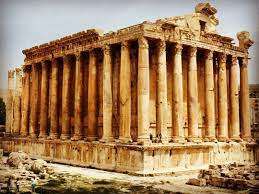
b. Key Architectural Features:
Temples dedicated to Ra were often grand edifices, reflecting his supreme status. A quintessential Ra temple usually housed an obelisk, a towering four-sided structure tapering towards the top, symbolizing a petrified ray of the sun. The temple’s sanctum, where the deity’s image or symbol was placed, was designed to allow sunlight to illuminate it at specific times, typically during significant rituals or solstices. Pillars, often carved with hieroglyphs and reliefs, showcased Ra’s tales and his associations with other deities.
c. Rituals Associated with Ra Temples:
The daily worship of Ra was an elaborate affair, orchestrated with precision and reverence. Every dawn, in a ritual symbolic of rebirth, priests would cleanse, anoint, and dress the deity’s statue, chanting hymns that echoed the creation myth. Offerings of food, flowers, and incense were presented, ensuring Ra’s benevolence. As evening approached, another ceremony marked the sun’s descent, with rituals ensuring Ra’s safe passage through the underworld. Annual festivals, especially those marking the solar cycle, saw processions, feasts, and music, transforming temples into vibrant hubs of communal celebration.
By diving deep into the architectural marvels and rituals associated with Ra’s worship, we gain a tangible sense of how deeply embedded he was in the daily rhythms and spiritual psyche of ancient Egypt.
6. Ra’s Legacy in Modern Culture:
Ancient Egyptian civilization may have reached its peak long ago, but its unmistakable marks still weave through modern culture. Ra, holding a commanding presence in Egyptian mythology, doesn’t just reside on dusty scrolls or faded temple walls. Instead, his legacy thrives, finding resonance in modern media, literature, and the collective consciousness of Egypt.
a. References in Literature, Movies, and Other Forms of Media:
Modern literature often dips into the rich well of Egyptian myths, with Ra featuring prominently. From novels that reimagine his tales to academic works delving into his significance, Ra’s stories are retold and reinterpreted for new generations. In cinema, movies like “Gods of Egypt” draw inspiration from Egyptian pantheon tales, bringing Ra and other gods to the big screen with grand visual effects. Video games, like the popular ‘Assassin’s Creed: Origins’, integrate Egyptian myths, letting players navigate a world where Ra’s influence is palpable. Furthermore, in music, lyrics, and album art, we occasionally spot nods to this powerful sun deity.
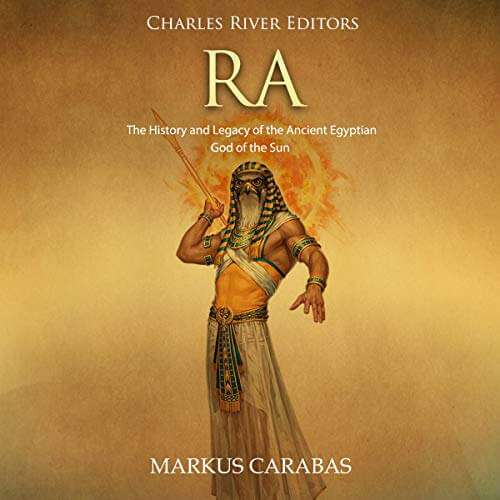
b. The Continued Importance of Ra in Contemporary Egyptian Culture and Spirituality:
Egypt, with its millennia-old history, is a land where the ancient and the modern often intermingle. Ra, while no longer worshipped in grand temples, is still a figure of reverence. As a symbol of light, life, and order, his essence can be found in local customs, folktales, and expressions. Tourist sites, with guides recounting Ra’s tales, rekindle his stories daily. Moreover, the sun, Ra’s primary symbol, continues to hold spiritual significance for many Egyptians, representing hope, rebirth, and the divine. Cultural festivals, art installations, and even some spiritual sects draw from Ra’s mythology, ensuring that his legacy is not just preserved but continuously revitalized.
In tracing Ra’s footprints in contemporary culture, we realize that gods, in their timeless wisdom and might, transcend eras. They adapt, evolve, and find relevance, resonating with generations far removed from their origin, yet still seeking the light they offer.
7. Fact-checking and Myths Debunked:
The allure of ancient myths often leads to their romanticization, and in the process, facts get distorted, and misconceptions arise. Ra, as a prominent deity, hasn’t been immune to such misinterpretations. In the age of information, it becomes imperative to sieve fact from fiction and present an authentic picture of the Sun God.
a. Correcting Common Misconceptions about Ra:
- Confusion with other deities: Primarily, people associate Ra with the sun, but they must distinguish him from other solar deities such as Horus and Atum. Although they share overlapping attributes and myths sometimes merge them, each deity has its own unique significance.
- The Aging Sun God: A common narrative posits Ra as an old, weakening god, especially in the Isis-secret-name myth. While this tale does underscore his vulnerability, it doesn’t imply Ra’s diminishing power. Instead, it showcases the cyclical nature of life, where even gods experience phases of strength and vulnerability.
- Uniform Worship: People in ancient Egypt did not universally revere Ra, as his worship had regional variations, and changing dynasties caused his significance to ebb and flow.
b. Highlighting Inaccuracies in Popular Renditions of Ra’s Myths:
- Hollywood’s Ra: Films and TV series often take creative liberties, presenting a version of Ra that’s more fiction than fact. From his physical representation to the dramatization of his tales, these renditions, while entertaining, often stray from authentic sources.
- Over-simplified Creation Myth: Modern retellings sometimes present Ra’s creation myth as a straightforward act of him speaking the world into existence. While this is a part of the tale, the complete narrative is nuanced, encompassing the Ogdoad, the primordial waters of Nun, and Ra’s emergence as a child or a lotus.
- Modern Fiction and Literature: Various novels and comics introduce Ra as a character, often endowing him with attributes or backstories that don’t align with ancient texts. While these are meant for entertainment and aren’t factual accounts, it’s crucial to differentiate them from the source myths.
In debunking myths and correcting misconceptions about Ra, we aim to honor the authentic tales that have endured millennia, ensuring that readers and enthusiasts get a genuine glimpse of the Sun God’s grandeur.
8. Conclusion:
Throughout millennia, the resplendent figure of Ra has cast a luminous shadow over the tapestry of Egyptian culture and beyond. As the embodiment of the sun, he symbolized life’s very essence, guiding ancient Egyptians in their daily rhythms and spiritual quests. Today, literature, cinema, and the collective memory of a nation that once positioned him at the cosmos’s center don’t just confine Ra’s legacy to archaeological relics or scholarly texts; they let it thrive. While this exploration provides a glimpse into Ra’s vast realm, true appreciation unfolds only by delving deeper into Egyptian mythology. To all readers, the journey through these ancient tales promises not just knowledge but a connection to an era where gods walked among mortals, and every sunrise was a testament to Ra’s eternal grace.
